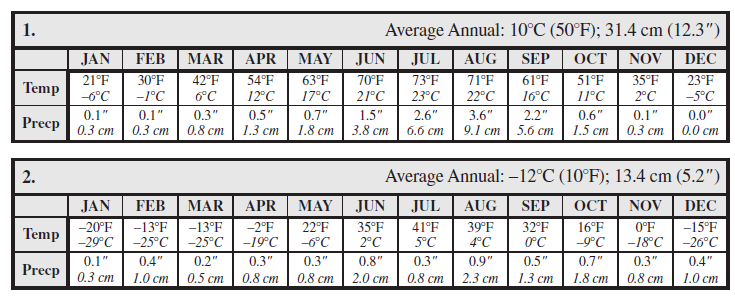In 1789, when the United States gained independence from Britain, the population of the 13 colonies was dominated by immigrants from Western Europe, but there were also large numbers of ________ and ________
Fill in the blank(s) with correct word
African-American slaves, Native Americans
You might also like to view...
For each of the following six locations, complete the climograph using the average monthly temperature (“Temp”) given in degrees Celsius and Fahrenheit, and the average monthly precipitation (“Precp”) given in centimeters and inches. The average annual temperature and precipitation are provided for you. After completing the climographs, answer the questions at the end of Part II. You may plot data on the climographs using either S.I. or English units (note that the English unit and S.I. unit scales on the climographs are not exactly equivalent). No “H” climates are given.


It is well known by now that industrial production usually entails pollution of some sort, and often hazardous production practices. And yet this production continues. On what basis are these practices usually defended? What are some of the counter- arguments?
What will be an ideal response?
What type of rocks yield the best age determinations from isotopic dating?
A. Metamorphic rocks B. Plutonic igneous rocks C. Sedimentary rocks D. Volcanic igneous rocks
Modern geochronology studies recognize that most radiometric dates record a time when a mineral cools below a temperature where the mineral closes to gain or loss of parent and daughter isotopes
This "closure temperature" varies between different minerals and different isotopic systems. This has allowed the absolute dating of sedimentary rocks through dating of single crystals. For example, if a rock is heated above the closure temperature of the rocks constituent minerals, the date of that mineral provides a minimum age. In contrast, if the rock contains a mineral with a closure temperature higher than the maximum temperature reached by the rock, that mineral will retain the age from its source. The mineral zircon dated by U-Pb methods is an example. So, you look at a rock that has Cretaceous fossils in it, but your paleontologist friend looks at them and cannot determine if they are Early or Late Cretaceous in age. The rock contains the mineral apatite, which accumulates He through the decay or U and Th, but closes to He loss at temperature of around 75°C. You know from the stratigraphic section that the rocks were originally buried at least 3km. The local geothermal gradient is about 35°C/km. You obtain an apatite He date of 105 +/- 2 million years. You also date 100 grains of zircon from the rock. The zircons yield dates that range in age from 2.1 billion years to 125 million years. Three different zircon grains yield ages between 125 and 127 million years. You google "cretaceous time scale" and learn that the Cretaceous begins at about 144 million years and ends at about 65 million years ago. The Early Cretaceous ends about 100 million years ago. How old are these sedimentary rocks?